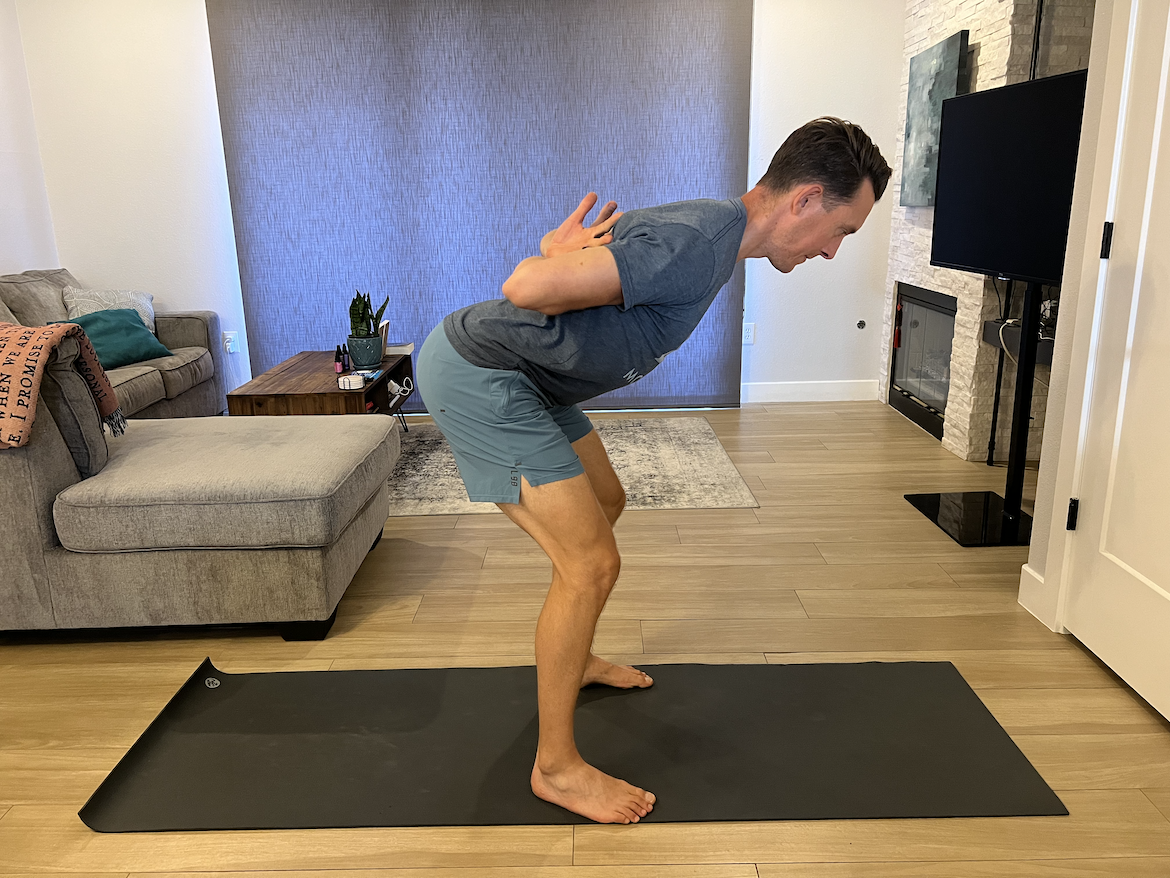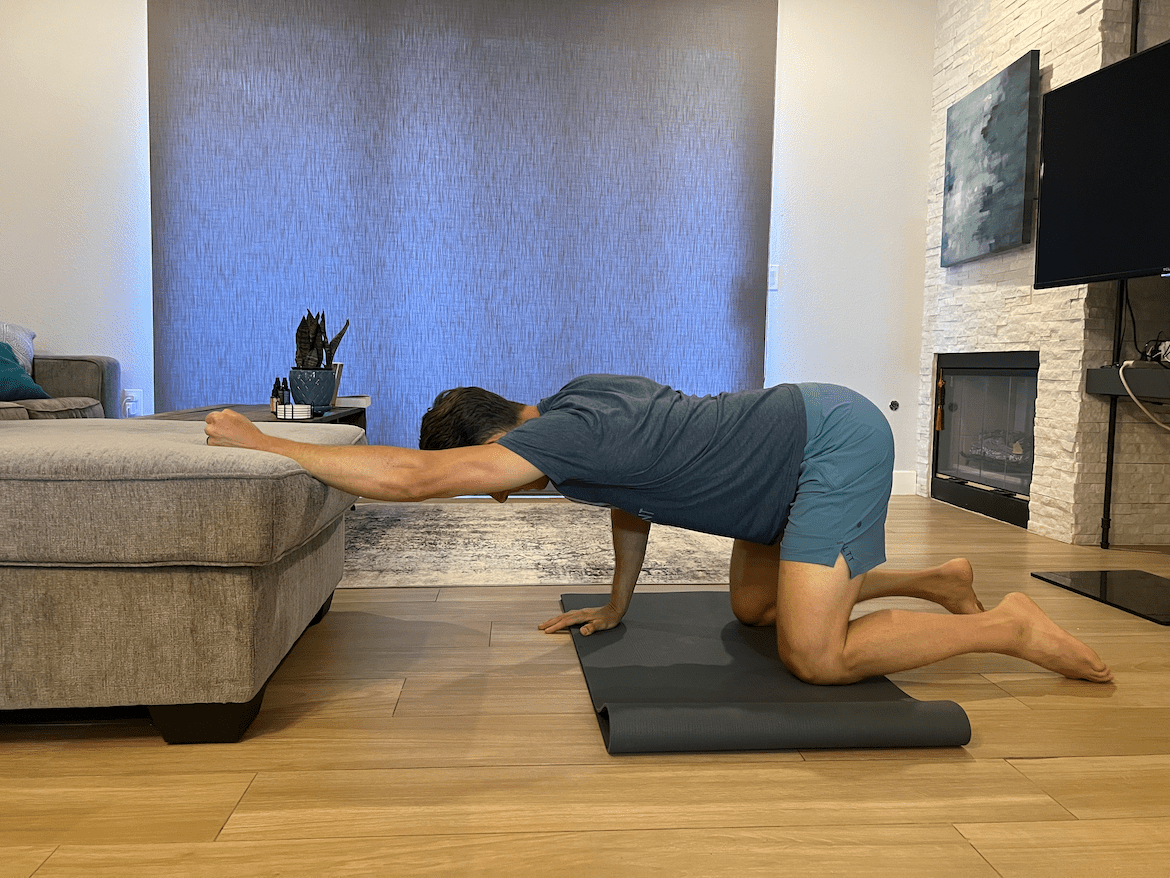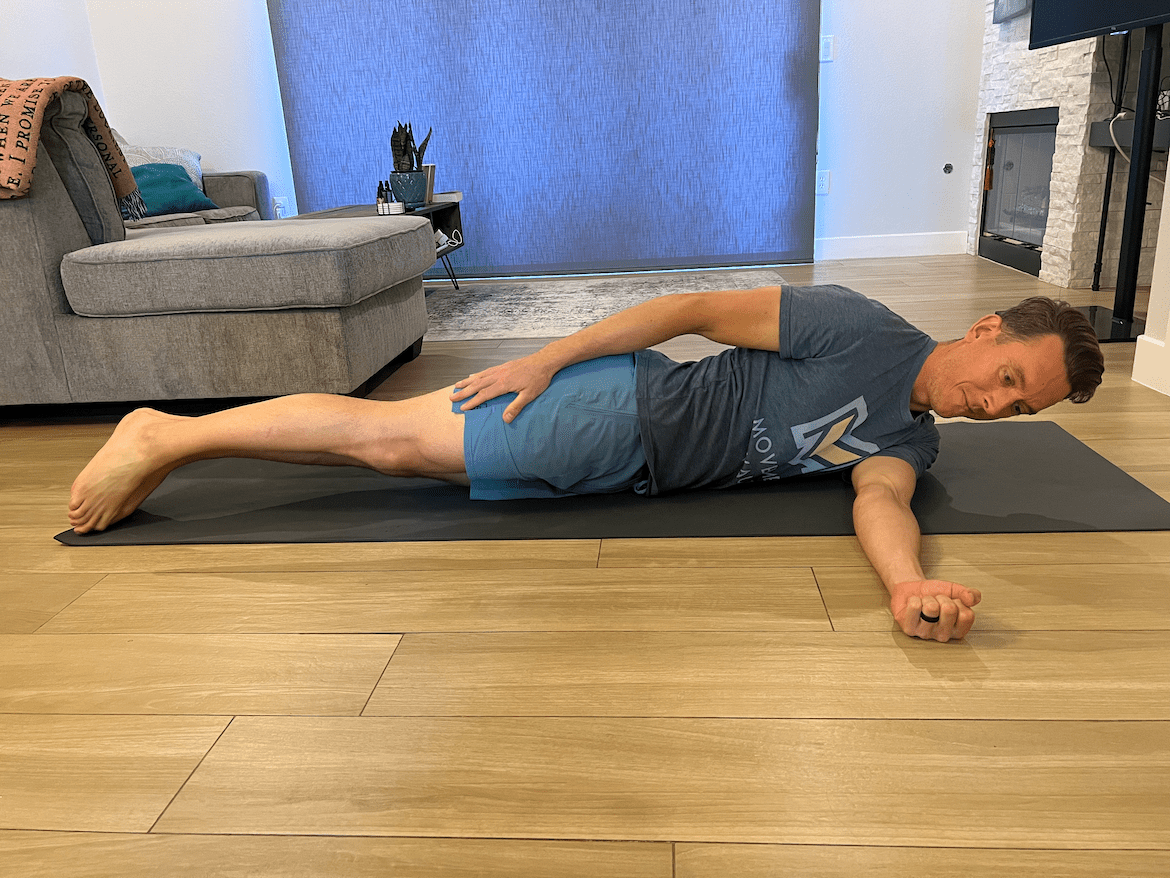We use our shoulders for almost each little factor we do: reaching for a can at the back of the cupboard; placing a e-book on a excessive shelf; slipping our arm right into a sleeve; brushing our enamel. So when you’ve a bum shoulder, it’s, properly, a giant bummer.
Most individuals with shoulder ache have some type of rotator cuff tear or damage. Issues with the rotator cuff—one of the necessary elements of the shoulder—are tremendous frequent (extra on why later). Yearly, greater than 2 million People see their physician complaining of rotator cuff ache, in accordance with the Cleveland Clinic.
Whereas stopping a rotator cuff damage isn’t at all times doable, displaying your shoulder some love within the type of each day rotator cuff stretches can definitely decrease your probabilities. Learn on to study extra in regards to the rotator cuff, together with why it’s vulnerable to ache, the very best stretches to maintain it lengthy and limber, and what to do if you find yourself with an damage.
What’s the rotator cuff, precisely?
“The rotator cuff is a gaggle of comparatively small muscle tissue [and tendons] that connect to the entrance and the again of the shoulder,” says Anna Hammond, DPT, OCS, PCES, a bodily therapist at Core Train Options.
“The shoulder joint is a ball and socket joint,” so the rotator cuff muscle tissue “work collectively to assist preserve the ball centered within the socket,” Hammond says. In different phrases, it holds your shoulder in place and stabilizes the joint, so you are able to do issues like elevate your arms or attain overhead.
Why is the rotator cuff vulnerable to damage?
“The quick reply is most individuals have tight or weak rotator cuff muscle tissue,” says Grayson Wickham, DPT, CSCS, founding father of the Motion Vault.
Sometimes, tight rotator cuff muscle tissue on the entrance of the shoulder (together with the pectoralis minor) will pull the shoulders ahead (i.e., out of correct alignment), he says. The rotator cuff muscle tissue on the again of the shoulder can be weak or unstable.
This lack of stability often has to do with repeated poor posture (assume: slumping in entrance of a laptop computer 9 hours a day), Wickham says. Not actively stretching or strengthening the muscle tissue additionally performs a component.
Drawback is, poor shoulder mobility and stability units off a dangerous domino impact, one thing Wickham calls the “joint ache and damage cycle.” The cycle is:
- Tight or unstable shoulder muscle tissue trigger compensations in your rotator cuff
- These compensations result in joint wear-and-tear (on this case, micro-tearing of particular rotator cuff muscle tissue equivalent to your supraspinatus)
- This joint wear-and-tear finally results in ache and damage
Making issues worse, we rely on the rotator cuff for lots of on a regular basis actions (assume: combing our hair, pushing a vacuum) so it will get quite a bit of wear-and-tear. Over time, this overuse damages and weakens the shoulder, making it much more vulnerable to damage, in accordance with Harvard Well being Publishing.
On high of all this, the motion of the rotator cuff includes the sequencing of many muscle tissue together with the scapula (shoulder blade), the humerus (higher arm bone), and the rib cage, Hammond says. “If one element is not working properly, the rotator cuff can simply get pinched within the joint house or set as much as overwork,” she says.
Find out how to know you probably have a rotator cuff damage
Tears are one of the frequent rotator cuff accidents. They will occur by accident, say, for those who fall, or they could be a byproduct of wear-and-tear from repetitive actions and common growing older.
Signs of a rotator cuff tear embrace, per the Cleveland Clinic:
- Problem elevating or transferring your arm with out ache or discomfort
- Common weak spot in your shoulder joint
- Much less vary of movement in your shoulder
Tendonitis (or irritation of tendons within the shoulder) is one other frequent rotator cuff downside. When it’s extreme, tendonitis may even trigger a rotator cuff tear.
Signs of rotator cuff tendonitis embrace, per Harvard Well being Publishing:
- A uninteresting ache across the outdoors tip of the shoulder that will get worse once you push, pull, attain overhead, or elevate your arm as much as the facet
- Ache once you lie on the affected shoulder
Can rotator cuff stretches forestall an damage?
The quick reply: sure, partly. “The simplest method to forestall rotator cuff accidents is to enhance your total shoulder mobility and stability,” Wickham says. This implies ensuring the muscle tissue on the back and front of your shoulder are sturdy and versatile.
“The simplest method to forestall rotator cuff accidents is to enhance your total shoulder mobility and stability.”—Grayson Wickham, DPT
Focused stretching is a part of this equation. “An efficient shoulder mobility program will embrace particular rotator cuff energetic stretches,” Wickham says. The important thing phrase being energetic. “Static stretching is not going to enhance your rotator cuff vary of movement or stability,” he says.
The opposite pivotal piece for stopping a rotator cuff damage is strengthening the shoulder muscle tissue. Muscle activation workout routines will assist improve rotator cuff mobility and stability. particularly with overhead actions, Wickham says.
Hammond agrees: “it is a few well-balanced weight coaching program that helps make certain your scapula strikes properly in all planes of movement and with management.”
“Sometimes, deal with rib cage mobility and eccentric lengthening workout routines of the serratus, pecs, lats, and subscap,” Hammond says. “The eccentric focus of an train helps provide you with size and energy” in these muscle tissue, she says. Each are needed for staying damage free.
Different advantages of rotator cuff stretches
“Along with damage prevention, performing rotator cuff energetic stretches and muscle activations will even enhance your efficiency in your each day life actions,” Wickham says.
A couple of on a regular basis issues you are able to do with extra ease (and fewer ache) when your rotator cuff is in tip-top form:
- Attain excessive in your cabinet to get one thing
- Open a door
- Carry your groceries
- Brush your hair
Including rotator cuff stretches to your common routine can even stage up your health within the fitness center or in your sport, Wickham says. You’ll be higher at push-ups, bench press, pull-ups, throwing a baseball or soccer, or swinging a tennis racket, simply to call a number of.
Greatest rotator cuff stretches to stop damage
These shoulder workout routines, which you are able to do at house, are really helpful by Wickham to construct vary of movement and adaptability, and enhance stability and mobility inside the shoulder joint to assist forestall damage in your rotator cuff. For the very best outcomes, incorporate them right into a well-balanced strength-training routine.
1. Rotator Cuff Muscle and Fascia Lively Launch Mendacity With Ball
This targets and unlocks your posterior rotator cuff muscle tissue (those within the again) by lowering neurologic muscle tone, Wickham says. We like to make use of a Set off Level Therapeutic massage Ball for fascia stretches, however a lacrosse and even tennis ball will work simply as properly.

- Begin by mendacity in your again with one arm lifted straight overhead.
- Place the mobility ball in your rotator cuff muscle tissue of your overhead arm. To search out these muscle tissue, take your reverse hand and attain over your shoulder to seek out the backbone of your shoulder blade.
- Place the ball beneath this backbone. The ball needs to be on the underside half of your shoulder blade.
- Internally and externally rotate your shoulder. To do that, level your thumb upward towards the ceiling, after which rotate your shoulder, pointing your thumb downward so far as you may towards the bottom.
- It’s also possible to discover different areas in your rotator cuff by transferring the ball barely in both path.
- Proceed this shoulder rotation motion whereas mendacity on the ball for two minutes. Swap and repeat in your different shoulder.
2. Sleeper Stretch Lively Stretch
“This energetic stretch and activation train targets the again of your shoulder,” Wickham says. “It maximally stretches and prompts your posterior rotator cuff muscle tissue and improves shoulder rotation.”

- Begin by mendacity on one facet with a slight bend at your hips.
- Your physique might be in a V place. Relaxation your head on high of a pillow, foam curler, or yoga block.
- Level your backside forearm and hand straight at your hip crease. This can present you the place your arm needs to be.
- Preserve the again of your shoulder and elbow of the underside arm on the bottom the whole time.
- Take your reverse hand and place it on the highest of your different forearm and push down so far as doable.
- It is best to now really feel a maximal stretch at the back of your shoulder that’s on the bottom.
- Whereas staying within the stretch, contract these muscle tissue by making an attempt to push your wrist into your reverse hand that’s holding your forearm down and offering resistance.
- Maintain this contraction for 20 seconds.
- Subsequent, calm down the muscle tissue, however keep within the stretch and contract the muscle tissue on the opposite facet of your shoulder by making an attempt to push your hand and forearm in direction of the bottom even farther, so far as doable.
- Maintain this contraction for 10 seconds.
- That’s 1 rep; full 3 reps. It is best to have the ability to get a bit deeper into the stretch with each repetition. Then change arms.
3. Reverse Snow Angels Standing
It is a nice transfer just like shoulder flossing to enhance full energetic vary of movement and stability of your shoulders in quite a few positions, as a result of it targets all the muscle tissue round your shoulder blade and shoulders.

- Stand along with your toes shoulder-width aside.
- Push your hips again so far as doable till your chest is parallel to the bottom otherwise you really feel a stretch at the back of your hamstring muscle tissue.
- Preserve your again flat the whole time. Along with your fingers by your facet, and palms dealing with up, prolong your shoulders upward as excessive as doable.
- Bend your elbows and produce your fingers behind your again, making an attempt to the touch the bottoms of your reverse shoulder blades.
- Straighten your elbows, flip your palms down, and unfold aside your shoulder blades whereas bringing your arms out to the facet after which overhead so far as doable.
- As soon as your arms are maximally stretched out overhead, reverse the above steps, by pinching your shoulder blades collectively as you progress your arms out to the facet after which again all the way down to your facet.
- Flip your palms upward and prolong your shoulders as excessive as doable upward.
- That’s 1 rep; carry out 3 units of three reps.
“The purpose of this train is to maneuver your shoulders and shoulder blades by way of their most pain-free vary of movement,” Wickham says. So you probably have ache at any level, modify the stretch till the vary of movement is extra snug for you.
4. Shoulder Flexion Lively Stretch
By specializing in the entrance and facet of your shoulder, particularly your lat and rotator cuff muscle tissue, this transfer improves overhead mobility and stability, in accordance with Wickham. It is also an effective way to stretch out shoulder knots.

- Begin in your fingers and knees. Place one hand along with your thumb dealing with upward onto a field, bench, or piece of furnishings.
- Preserving your elbow straight the whole time, push your chest all the way down to the bottom so far as doable till you are feeling a maximal stretch within the entrance and facet of your shoulder.
- Whereas staying on this stretch, contract the shoulder muscle tissue by driving your hand and arm into the field and holding this contraction for 20 seconds.
- Subsequent, calm down the muscle tissue, however stay within the stretch. Contract the muscle tissue on the opposite facet of your shoulder by making an attempt to elevate your hand up off of the field as excessive as doable. You in all probability received’t have the ability to elevate your arm as a result of it’s maximally stretched (which is completely regular), however the thought is to inform your muscle tissue to strive. Maintain this contraction for 10 seconds.
- This equals 1 rep; do 3 reps, then change arms.
5. Cross-Chest Posterior Shoulder Eccentrics
This energetic stretch and activation train targets the again of your shoulder to enhance posterior rotator cuff mobility and stability, Wickham says.

- Begin by mendacity in your facet with one arm straight out in entrance of you, palm dealing with up.
- Contract the muscle tissue on the again of your shoulder in your straight arm by pushing the again of your hand and arm down into the bottom.
- Whereas holding this contraction, slowly decrease your reverse shoulder and chest all the way down to the bottom so far as doable. This could take you about 5 seconds.
- Be certain to proceed to press your arm down into the bottom, contracting this muscle the whole time. It is best to really feel it at the back of your shoulder.
- Subsequent, transfer your arm upward about 6 inches and repeat the steps above.
- This equals 1 rep. Full 10 reps and repeat on the opposite facet.
6. Pectoralis Lively Stretch
In case you’ve ever completed a chest stretch by way of an open doorway, this transfer may be very related. It provides some contractions to the muscle tissue on the entrance of your shoulder, particularly your pectoralis muscle tissue, to not simply stretch your entrance shoulder however enhance its stability, too.

- Begin by mendacity in your abdomen with one arm straight out to your facet at a 90-degree angle out of your physique and palm down.
- Utilizing your reverse arm for assist, elevate and rotate your reverse hip and leg off of the bottom, so far as doable backward. This can enhance the stretch within the entrance of the shoulder of your straight arm.
- Whereas staying within the stretch, contract the shoulder muscle tissue by driving your hand and arm into the bottom. Maintain this contraction for 20 seconds.
- Subsequent, calm down the muscle tissue, however keep on this stretch. Contract the muscle tissue on the again of your shoulder by making an attempt to elevate your hand and arm up off of the bottom as excessive as doable. Maintain this contraction for 10 seconds.
- In case you are deep into the stretch, you won’t be able to elevate your arm a lot (it is a good factor). Proceed to contract the muscle tissue on the again of your shoulder.
- Briefly come out of the stretch and bend your elbows 3 occasions. Then place your arm again on the bottom, however transfer it about 6 inches upward. Repeat the identical steps above.
- Proceed this motion sample, transferring your arm upward every time till it’s nearly straight overhead. The upper you progress your arm upward, the much less it is possible for you to to rotate your physique.
- Repeat on the other facet.
Workout routines to keep away from with an injured rotator cuff
Whereas relaxation is essential for restoration, you shouldn’t cease transferring your shoulder altogether. This will trigger “frozen shoulder,” a situation that happens when shoulder tissues shrink and scale back its vary of movement, in accordance with Harvard Well being Publishing. Staying energetic will assist forestall this downside and preserve your shoulder limber.
That mentioned, you’ll additionally should be cautious about which workout routines you select to do—you don’t need to worsen your damage (or your ache). Sure workout routines, like overhead actions (or something that includes elevating your arms) and horizontal pushing actions, can worsen a rotator cuff damage, Wickham and Hammond say.
Some workout routines to keep away from with a rotator cuff damage:
Different (maybe shocking) workout routines that add pressure to a foul shoulder embrace, per the Cleveland Clinic:
- Deadlifts (they’ll pull your arm out of your socket and place a ton of stress on the rotator cuff)
- Shrugs (they pull down in your shoulder)
- Squatting with a barbell (resting the bar throughout your shoulders can stress the rotator cuff)
Nonetheless, everybody (and each damage) is completely different. “The precise stretches and workout routines to keep away from rely in your extent of harm and your present shoulder mobility and stability stage,” Wickham says. “Let the discomfort down your arm be your information,” Hammond says. Merely put: if one thing hurts, cease doing it.
Merely put: if one thing hurts, cease doing it.
Alternatively, you may also accommodate your shoulder by modifying (on this case, decreasing) the vary of movement of an train or stretch, Wickham provides. As you get well, you’ll progressively rebuild vary of movement and energy.
FAQ
What if I have already got a rotator cuff damage?
Generally even once you handle your shoulders (learn: stretch and strengthen them repeatedly), accidents nonetheless occur (argh). Now what?
Whereas it’d take a while, most accidents can heal with a bit assist. It often takes two to 4 weeks to get well from rotator cuff tendonitis or a small tear, in accordance with Harvard Well being Publishing. For extra severe tears, the therapeutic course of might final a number of months.
Both means, with endurance and a few TLC, you may efficiently get well from a rotator cuff damage (and relieve rotator cuff ache). Right here’s how, per the Cleveland Clinic:
- Relaxation (and possibly an arm sling) to provide your overused shoulder much-needed downtime.
- Nonsteroidal anti-inflammatory medication (NSAIDs) to restrict ache and swelling.
- Steroid injections to ease ache and swelling.
- Bodily remedy for rebuilding vary of movement and energy.
Can a rotator cuff heal by itself?
Fortunately, many rotator cuff accidents—together with tendonitis and tears—can heal with bodily remedy (and with out surgical procedure), in accordance with Harvard Well being Publishing.
Working example: 8 of 10 folks with partial rotator cuff tears make a full restoration utilizing conservative remedies (assume: ice, NSAIDs, bodily remedy), per the Cleveland Clinic.
Nonetheless, “not all rotator cuff accidents are created equal,” Hammond says. “You possibly can have completely different thicknesses or variety of muscle tissue concerned.”
In different phrases, whether or not you may get higher by yourself will depend on “the extent of harm, a.ok.a., muscle tearing,” Wickham provides. Much less severe rotator cuff tears (like grade one or two tears, for instance) will be efficiently rehabbed with the assist of a bodily therapist, he says.
“An efficient rotator cuff tear rehab program is not going to solely assist you to lower your shoulder ache, however will even repair the foundation reason behind your rotator cuff tear, which generally is poor shoulder mobility and stability,” Wickham says.
“It can additionally deal with different areas of your physique as properly equivalent to higher again mobility, core stability and even hip mobility,” he says. “Poor mobility in these areas will trigger further compensation in your shoulders, which is able to usually result in wear-and-tear and finally shoulder ache and damage.”
Alternatively, extra extreme accidents, like grade three tears, will usually require surgical procedure, Wickham says.
What’s the finest place to alleviate rotator cuff ache?
An injured rotator cuff will be fairly painful. You may discover it troublesome to get snug in any place.
“Sometimes, mendacity in your injured shoulder is the worst place,” Wickham says. Right here’s what to do as a substitute to alleviate ache when mendacity in your facet:
- Depart your arm by your facet whereas sitting (or standing). Elevating your arm overhead can worsen the discomfort.
- When mendacity down, lie in your reverse (i.e., wholesome) shoulder. In case you nonetheless have ache on this place, put a giant pillow underneath the highest/affected arm to assist assist it/forestall it from getting pulled throughout your physique.
“Mendacity in your again is usually painful too,” Hammond says. To assist:
- Put a pillow underneath your affected arm along with your hand in your abdomen.
- Place a small towel behind the again of shoulder (the thought isn’t to shove the shoulder ahead however reasonably to deliver the mattress or floor as much as it to assist it calm down and really feel supported).
If sitting is painful, do this, Hammond says:
- Fold a pillow in half to place underneath your arm earlier than you sit down.










